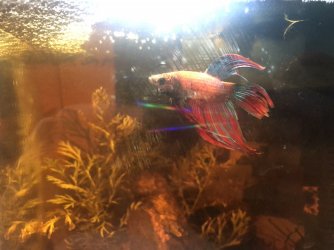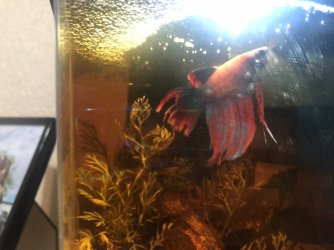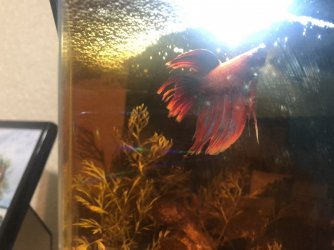My betta used to have such a beautiful billowing tail, but now it’s short with big chunks missing. A few weeks ago, he was not doing so well and so I put some catappa bark in his tank, and he has been doing so well since then! The water is very brown which you can see in the pictures, and the lady at my fish store told me these were the tannins being released and that it is not harmful, so I have not done anything to fix the color. He still swims around happy as can be all day and he still eats well. I have been looking for white or black along the edges but I don’t see any. His tail is definitely the most severe by far, but his other fins are a bit ragged at the ends as well. Any ideas what this is?? Or what I should do to fix it? Water parameters are all good!
You are using an out of date browser. It may not display this or other websites correctly.
You should upgrade or use an alternative browser.
You should upgrade or use an alternative browser.
Fin Rot or Fin Nipping?
- Thread starter kmacask
- Start date
hi, there that is what is known as fin rot. this is where a betta has an injury and this leads to rotting, there are a few medicines one is called erythromycin but there are other you can also you aquarium salts, I would recommend putting your betta is a hospital tank and then use the medicine in there
hope this helps fin rot can be a big problem in bettas
ember04
hope this helps fin rot can be a big problem in bettas
ember04
Fin rot are caused by water qualities and bacterial infections.
Do daily water changes and substrate clean, make sure the water pH is the same by adding the Indian almonds leaves in the water before adding to the tank.
Do daily water changes and substrate clean, make sure the water pH is the same by adding the Indian almonds leaves in the water before adding to the tank.
Looks like fin rot to me.
Fin rot is one of the most common. This disease forms due to poor water quality and affects the fins. Bettas that have had recent injuries to the fins are the most at risk to develop fin rot. Fin rot can be treated easily. 75%+ daily water changes per day, for a week usually clears up fin rot. Added aquarium salt can also reduce the chance of infection. The same treatment above can help solve a few of the common injuries including missing scales and torn fins. Weekly water changes after the fin rot has disappeared will help prevent this in the future.
You can read here for additional information on common Betta diseases.
Fin rot is one of the most common. This disease forms due to poor water quality and affects the fins. Bettas that have had recent injuries to the fins are the most at risk to develop fin rot. Fin rot can be treated easily. 75%+ daily water changes per day, for a week usually clears up fin rot. Added aquarium salt can also reduce the chance of infection. The same treatment above can help solve a few of the common injuries including missing scales and torn fins. Weekly water changes after the fin rot has disappeared will help prevent this in the future.
You can read here for additional information on common Betta diseases.
Tannins are perfectly safe for fish and don't cause this.
It looks like someone has bitten sections out of his tail. Are there any other fish in the tank?
The best treatment is big daily water changes and a bit of salt.
Wipe the inside of the glass down with a clean fish sponge.
Do a 75% water change and gravel clean the substrate every day for at least a week. The water changes and gravel cleaning will reduce the number of disease organisms in the water and provide a cleaner environment for the fish to recover in.
Make sure any new water is free of chlorine/ chloramine before it is added to the tank.
Clean the filter if it hasn't been done in the last 2 weeks. However, if the filter is less than 6 weeks old, do not clean it. Wash the filter materials/ media in a bucket of tank water and re-use them. Tip the bucket of dirty water on the garden/ lawn.
Increase surface turbulence/ aeration when using salt or medications because they reduce the dissolved oxygen in the water.
Add some salt, (see directions below).
----------------------
SALT
You can add rock salt (often sold as aquarium salt), sea salt or swimming pool salt to the aquarium at the dose rate of 1 heaped tablespoon per 20 litres of water. If there is no improvement after 48 hours you can double that dose rate so there is 2 heaped tablespoons of salt per 20 litres.
If you only have livebearers (guppies, platies, swordtails, mollies), goldfish or rainbowfish in the tank you can double that dose rate, so you would add 2 heaped tablespoons per 20 litres and if there is no improvement after 48 hours, then increase it so there is a total of 4 heaped tablespoons of salt per 20 litres.
Keep the salt level like this for at least 2 weeks but no longer than 4 weeks otherwise kidney damage can occur. Kidney damage is more likely to occur in fish from soft water (tetras, Corydoras, angelfish, Bettas & gouramis, loaches) that are exposed to high levels of salt for an extended period of time, and is not an issue with livebearers, rainbowfish or other salt tolerant species.
The salt will not affect the beneficial filter bacteria but the higher dose rate (4 heaped tablespoons per 20 litres) will affect some plants and some snails. The lower dose rate (1-2 heaped tablespoons per 20 litres) will not affect fish, plants, shrimp or snails.
After you use salt and the fish have recovered, you do a 10% water change each day for a week using only fresh water that has been dechlorinated. Then do a 20% water change each day for a week. Then you can do bigger water changes after that. This dilutes the salt out of the tank slowly so it doesn't harm the fish.
When you do water changes while using salt, you need to treat the new water with salt before adding it to the tank. This will keep the salt level stable in the tank and minimise stress on the fish.
It looks like someone has bitten sections out of his tail. Are there any other fish in the tank?
The best treatment is big daily water changes and a bit of salt.
Wipe the inside of the glass down with a clean fish sponge.
Do a 75% water change and gravel clean the substrate every day for at least a week. The water changes and gravel cleaning will reduce the number of disease organisms in the water and provide a cleaner environment for the fish to recover in.
Make sure any new water is free of chlorine/ chloramine before it is added to the tank.
Clean the filter if it hasn't been done in the last 2 weeks. However, if the filter is less than 6 weeks old, do not clean it. Wash the filter materials/ media in a bucket of tank water and re-use them. Tip the bucket of dirty water on the garden/ lawn.
Increase surface turbulence/ aeration when using salt or medications because they reduce the dissolved oxygen in the water.
Add some salt, (see directions below).
----------------------
SALT
You can add rock salt (often sold as aquarium salt), sea salt or swimming pool salt to the aquarium at the dose rate of 1 heaped tablespoon per 20 litres of water. If there is no improvement after 48 hours you can double that dose rate so there is 2 heaped tablespoons of salt per 20 litres.
If you only have livebearers (guppies, platies, swordtails, mollies), goldfish or rainbowfish in the tank you can double that dose rate, so you would add 2 heaped tablespoons per 20 litres and if there is no improvement after 48 hours, then increase it so there is a total of 4 heaped tablespoons of salt per 20 litres.
Keep the salt level like this for at least 2 weeks but no longer than 4 weeks otherwise kidney damage can occur. Kidney damage is more likely to occur in fish from soft water (tetras, Corydoras, angelfish, Bettas & gouramis, loaches) that are exposed to high levels of salt for an extended period of time, and is not an issue with livebearers, rainbowfish or other salt tolerant species.
The salt will not affect the beneficial filter bacteria but the higher dose rate (4 heaped tablespoons per 20 litres) will affect some plants and some snails. The lower dose rate (1-2 heaped tablespoons per 20 litres) will not affect fish, plants, shrimp or snails.
After you use salt and the fish have recovered, you do a 10% water change each day for a week using only fresh water that has been dechlorinated. Then do a 20% water change each day for a week. Then you can do bigger water changes after that. This dilutes the salt out of the tank slowly so it doesn't harm the fish.
When you do water changes while using salt, you need to treat the new water with salt before adding it to the tank. This will keep the salt level stable in the tank and minimise stress on the fish.
Any way to fix it without having a separate tank??hi, there that is what is known as fin rot. this is where a betta has an injury and this leads to rotting, there are a few medicines one is called erythromycin but there are other you can also you aquarium salts, I would recommend putting your betta is a hospital tank and then use the medicine in there
hope this helps fin rot can be a big problem in bettas
ember04
I will try a water change tonight!Fin rot are caused by water qualities and bacterial infections.
Do daily water changes and substrate clean, make sure the water pH is the same by adding the Indian almonds leaves in the water before adding to the tank.
Thank you! I will do a water change tonight!Looks like fin rot to me.
Fin rot is one of the most common. This disease forms due to poor water quality and affects the fins. Bettas that have had recent injuries to the fins are the most at risk to develop fin rot. Fin rot can be treated easily. 75%+ daily water changes per day, for a week usually clears up fin rot. Added aquarium salt can also reduce the chance of infection. The same treatment above can help solve a few of the common injuries including missing scales and torn fins. Weekly water changes after the fin rot has disappeared will help prevent this in the future.
You can read here for additional information on common Betta diseases.
Thank you for all the information! There only other things in his tank are a plant and a filter, so noones been taking bites out of his fins despite the big chunks missing, unless he is biting himself. I will do a water change tonight and continue for the week to see if anything changes. Will it get better or will it only stop from decaying farther?Tannins are perfectly safe for fish and don't cause this.
It looks like someone has bitten sections out of his tail. Are there any other fish in the tank?
The best treatment is big daily water changes and a bit of salt.
Wipe the inside of the glass down with a clean fish sponge.
Do a 75% water change and gravel clean the substrate every day for at least a week. The water changes and gravel cleaning will reduce the number of disease organisms in the water and provide a cleaner environment for the fish to recover in.
Make sure any new water is free of chlorine/ chloramine before it is added to the tank.
Clean the filter if it hasn't been done in the last 2 weeks. However, if the filter is less than 6 weeks old, do not clean it. Wash the filter materials/ media in a bucket of tank water and re-use them. Tip the bucket of dirty water on the garden/ lawn.
Increase surface turbulence/ aeration when using salt or medications because they reduce the dissolved oxygen in the water.
Add some salt, (see directions below).
----------------------
SALT
You can add rock salt (often sold as aquarium salt), sea salt or swimming pool salt to the aquarium at the dose rate of 1 heaped tablespoon per 20 litres of water. If there is no improvement after 48 hours you can double that dose rate so there is 2 heaped tablespoons of salt per 20 litres.
If you only have livebearers (guppies, platies, swordtails, mollies), goldfish or rainbowfish in the tank you can double that dose rate, so you would add 2 heaped tablespoons per 20 litres and if there is no improvement after 48 hours, then increase it so there is a total of 4 heaped tablespoons of salt per 20 litres.
Keep the salt level like this for at least 2 weeks but no longer than 4 weeks otherwise kidney damage can occur. Kidney damage is more likely to occur in fish from soft water (tetras, Corydoras, angelfish, Bettas & gouramis, loaches) that are exposed to high levels of salt for an extended period of time, and is not an issue with livebearers, rainbowfish or other salt tolerant species.
The salt will not affect the beneficial filter bacteria but the higher dose rate (4 heaped tablespoons per 20 litres) will affect some plants and some snails. The lower dose rate (1-2 heaped tablespoons per 20 litres) will not affect fish, plants, shrimp or snails.
After you use salt and the fish have recovered, you do a 10% water change each day for a week using only fresh water that has been dechlorinated. Then do a 20% water change each day for a week. Then you can do bigger water changes after that. This dilutes the salt out of the tank slowly so it doesn't harm the fish.
When you do water changes while using salt, you need to treat the new water with salt before adding it to the tank. This will keep the salt level stable in the tank and minimise stress on the fish.
I put a new filter in almost two weeks ago, and is still clean. I will clean it when it has been two weeks. And when I am doing water changes I will also clean my glass and gravel!
They do sometimes bite their own tails, or he might have caught it on something in the tank and ripped a piece out.
Assuming it's not infected, it should grow back in a month or so. Doing regular water changes and adding salt will normally clear up any minor infections and allow the fish to heal itself.
If you have a new filter, do not clean it until it has finished cycling in about 6 weeks. If you remove/ replace the old filter media and put in new stuff, you will have ammonia problems that can cause this type of problem.
Assuming it's not infected, it should grow back in a month or so. Doing regular water changes and adding salt will normally clear up any minor infections and allow the fish to heal itself.
If you have a new filter, do not clean it until it has finished cycling in about 6 weeks. If you remove/ replace the old filter media and put in new stuff, you will have ammonia problems that can cause this type of problem.
Similar threads
- Replies
- 54
- Views
- 1K




